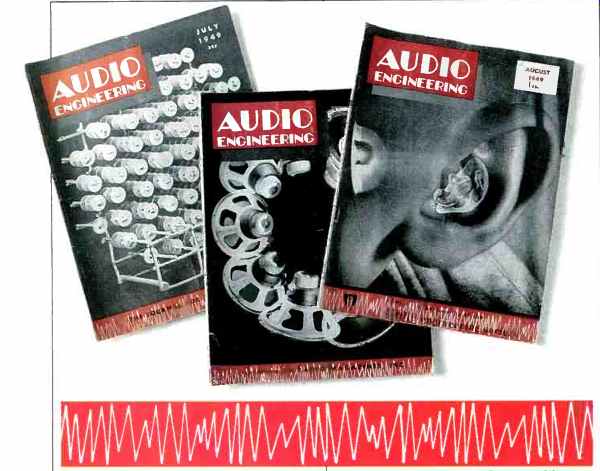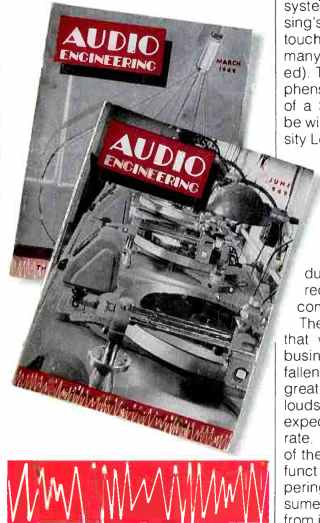A FAIR OF THE HEART

Recently I received a unique and fascinating missive from the Audio Engineering Society. It was entitled "A Memoir of Yesterday" and was a copy of the program for The Audio Fair and First Annual Convention of the Audio Engineering Society, on October 27, 28, and 29, 1949, at the Hotel New Yorker in New York City.
What a flood of memories this document unleashed! Audio magazine (called Audio Engineering then) was in its second year of publication, and 1949 really marked the beginning of the hi-fi industry. With the May 1991 issue, Audio entered its 44th year of publication and the' Audio Engineering Society will hold its 91st convention this October in New York City.
As digital audio technology will be the predominant subject at the 91st AES convention, so was magnetic recording at that first AES convention.
There were papers on "Operating Problems and Experiences" by an NBC engineer, "General Problems," "Standards-Present Status," "Improving Uniformity," "Distortion Measurements," "Speed Regulation by Control Frequency" by P. Brubaker of Ranger-tone (an early rival of Ampex, with a recorder similar to the German Magnetophon), and "Duplication by Contact Printing" by Herr and Johnston of 3M Co. (Some 17 years later, 3M flew me and some other audio writers in their company jet to St. Paul, Minn. to demonstrate a new version of a contact-printing tape duplication device. An incredibly complex machine, it never reached commercial production.) Of course, there were papers on other audio topics too. Among them was a paper, "A New Development in Directional Microphones," by famed engineer Harry F. Olson of RCA, whom I had the pleasure of knowing. Another paper was "A New Coupling Circuit for Audio Amplifiers," by F. H. McIntosh.
Yes, it was indeed the Frank McIntosh, in essence describing his famous bifilar-wound transformers that were a major feature of the first McIntosh amplifiers. There were also papers on audio measurements such as "The General Problem" by W. L. Black of Bell Telephone Laboratories, the famous engineer who developed feedback and feedforward circuitry. On the subject of intermodulation, there were contributions from a veritable Who's Who in audio--H. E. Roys of RCA, John K. Hilliard of Altec Lansing, and Norman Pickering of Pickering phono cartridge renown.

The exhibitors in the 1949 Audio Fair included many names and companies that became household words in the hi-fi industry. The Audio Fair was held at the New Yorker for quite a few years, and I attended all of them. Those were the golden years of hi-fi, when an audiophile could visit the Fisher exhibit and actually talk with Avery Fisher or hear Bozak loudspeakers demonstrated by Rudy Bozak. This held true for many other legendary names in hi-fi.
The companies that had exhibits at the 1949 Audio Fair are listed in the program the AES sent to me. It makes fascinating reading, and it is interesting to follow the fortunes of some of these companies through the years.
Audak Co., an early manufacturer of magnetic phono cartridges, has been gone for many years. Altec Lansing Corp. was prominent in theater sound installations and broadcast monitoring equipment, and their 15-inch 604B coaxial speaker was a favorite of many audiophiles. (Currently, there are two Altec Lansing companies, one in Oklahoma City, Okla., which still makes equipment for professional sound installations, the other a hi-fi speaker maker in Milford, Penn., with models up to $12,000 per pair.) Another exhibitor, Audio Devices (I'm not sure if they are still in business), made Audiotape, a rival to 3M's Scotch. Hewlett-Packard and Tektronix were also represented. 'Nuff said! Brush Development Co. made an early consumer-type tape recorder called the "Soundmirror" and it has passed into history. Brociner Laboratories was run by affable Victor Brociner who made some quite good integrated amps at low prices. That company is long gone. Frank Capps Co. made some of the best cutting styli for phono lacquers, but considering the moribund state of vinyl records, they may be out of business.
Cook Laboratories was the pride of legendary Emory Cook. He made all sorts of audio devices, but is best remembered for his famous specialty recordings. At one time Emory exhibited with his friend Rudy Bozak. Rudy made a pair of monstrous versions of his "Concert Grand" speakers, which weighed a quarter of a ton each!
Emory used them to play his recording of the Queen Mary's whistle, and the ensuing blast made it sound like the ship was sailing through the halls of the hotel! Those were the fun days of hi-fi! Emory had another recording of the turbines in the engine room of a Navy cruiser, and this, through the Bozaks, was awesome. Music? You bet, with some great organ recordings that really plumbed the low-frequency depths-quite remarkable for their day. Emory is still with us, but his company is no more. Electro-Voice was heavily into consumer loudspeakers, both raw speakers and systems, notably their huge "Patrician" corner horn.
They were also strong on high-quality microphones. They are still active today but not much of a factor in loudspeakers, prospering instead with their microphones and sound-reinforcement products.
Fairchild Recording Equipment Corp. allowed friend Sherman Fairchild to indulge his audio ideas. It made broadcast turntables and phono arms.
Joe Grado made the first stereo phono cartridge there and the Fairchild tape recorders were made famous by Bob Fine in his early Olympian series recordings for Mercury Records. That company is no longer in business. The Allan B. DuMont Co. was well-known for its TV sets and was a principal manufacturer of early color TV sets, but, alas, the company is just a memory now. H. J. Leak Ltd. of London, England, was Harold Leak's company made famous by its "Point One" tube amplifier. It, too, is long out of existence.
Frank H. McIntosh was the founder of one of the hi-fi industry's oldest and most respected companies. Together with the indefatigable Gordon Gow, McIntosh established a reputation for excellence in amplifiers and diverse audio equipment. Sadly, both Frank McIntosh and Gordon Gow are dead, but the company prospers under its new owner, Clarion Corp. Magnecord, Inc. was one of the pioneer manufacturers of magnetic tape recorders. I have previously detailed my involvement with them as sales executive and musical director, as well as my work in binaural and stereo recording. Their sun set many years ago. Permoflux Corp. was the designer and manufacturer of headphones used by pilots during World War ll. They were distinctive for their mustard yellow chamois ear cushions. Magnecord used Permoflux phones extensively for listening to binaural recordings. They hadn't much response above 8 kHz, but they were quite clean and smooth. To my knowledge they are out of business.
Pickering & Co. was founded by friend Norman Pickering but he left the business, and it became Stanton/Pickering. Norman lives not far from me, in Southampton, New York, where he makes violins and pursues other musical interests. Stanton/Pickering are dominant in the broadcast and DJ phono cartridge business, but, like all such companies, their consumer phono cartridge market is quite depressed. Rangertone Inc. was a pioneering manufacturer of tape recorders, based on "liberated" German Magnetophon designs. They never enjoyed the success of Ampex and went out of business long ago. Rek-O-Kut Company is a name well remembered by audiophiles. For a while in hi-fi's early days, they had a corner on the manual turntable business. If you were really into hi-fi, you owned one of their fancier tables featuring hysteresis-synchronous motors. The company is defunct.
Stancil-Hoffman Corp. was another pioneer manufacturer of tape recorders, mostly for the industrial market, and a specialty was logging recorders.
The company has been gone for years.
Stephens Manufacturing Co. made loudspeakers, raw drivers, and some systems quite similar to Altec Lansing's, but with quality and design touches that made them a favorite of many audiophiles (yours truly included). The company's founder, Bob Stephens was a figure in the heroic mold of a Sidney Greenstreet, great fun to be with and he had a great ear. University Loudspeakers Inc. was well-known for sound reinforcement equipment and then went into the consumer speaker business.
They made a large variety of raw drivers and furnished plans for elaborate multi-way systems.
They got ambitious and produced some electronics, notably a receiver, but it didn't fly and the company is kaput.
These were some of the companies that were the core of the early hi-fi business. As you can see, many have fallen by the wayside. There were a great many others, literally dozens of loudspeaker companies, which not unexpectedly had the highest attrition rate. In fact, it must be said that more of the early hi-fi manufacturers are defunct than still in business and prospering. Some things are sad-con sumer open-reel tape recorders went from inception to demise in a little more than 35 years. Oh, there are still a few being made, but their sales are insignificant. It is interesting to note that the advances in recording technology caused their downfall. When the compact cassette first appeared, it was sneeringly dismissed as a toy by the proud owners of open-reel recorders.
As time went by, and the top cassette recorders began to rival the open-reel in sound quality, the open-reel's death rattle could be heard.
It is nice to reflect that Audio was reporting on hi-fi matters at the dawn of the industry and 42 years after that 1949 Audio Fair, we are still at the old stand doing business!
(adapted from Audio magazine, Jun. 1991; Bert Whyte)
= = = =